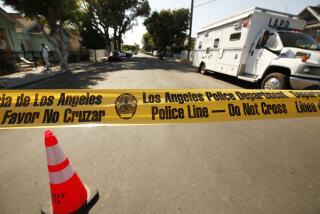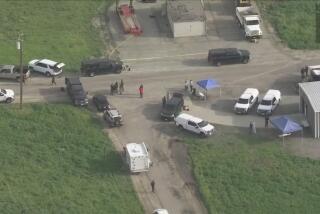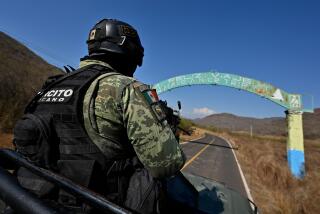Bomb Squad : Helping Defuse Explosive Situations
- Share via
They deal with the dangerous, the unpredictable and often the unknown. Their job: to disarm explosive devices while guaranteeing the safety of those around them. Bomb squad technicians are trained police officers, arson investigators and explosive specialists all rolled into one. And lately they’ve been busier than usual.
In the week following the Oklahoma City tragedy, the Los Angeles County Sheriff’s Department’s Arson-Explosives Detail, better known as the bomb squad, and responded to 24 reports of bombs. Typically, they might receive 10 such reports a week.
The 14 bomb technicians in the Los Angeles Police Department answer resports of suspicious objects throughout the city, from LAX and South-Central to Downtown and the San Fernando Valley. The 20 technicians of the county’s squad respond to calls outside city limits and also assist the LAPD and other area police departments.
Technicians check on questionable devices ranging from suspicious packages to homemade pipe bombs and military ordnances such as grenades. Robots are often used, helping to take technicians out of the line of danger. While some of their duties differ, the two bomb squads have similar procedures. Most of the information illustrated here is based on the Sheriff’s Department’s bomb squad, located in Whittier.
Bomb Suit
Over their regular uniforms technicians wear helmets and special protective suits that weigh about 75 pounds.
1) Made of Aramid fiber, a bullet-resistant material similar to Kevlar. Fire-resistant Nomex and other anti-static fibers help make the outer shell resistant to bomb fragments.
2) Protective shields made of Kevlar are inserted into suit.
3) Helmet made of polycarbonate and Aramid has a ventilator inside that takes in outside air, cooling technician and defogging Plexiglas visor.
4) Microphone and speakers in helmet allow technicians to communicate. Sound from outside is amplified.
5) During warm weather, cooling vests are worn under suit. Suit can only be worn for short periods during hot weather.
Robot
Used to approach questionable objects and disarm a device determined to be explosive, the bomb squad’s robot, called Andros, is controlled by computer from the squad truck. The department is getting an upgraded robot within a few weeks. LAPD has one robot, a smaller version.
* Size: 28 in. wide x 41.5 in. high x 31 in. long (62 in. long with tracks horizontal)
* Weight: 550 pounds, 700 pounds with extra equipment
* Speed: 1 to 16 in. per second.
* Mobility: Robot can maneuver on slopes to 45 degrees over a variety of terrain, climb stairs and over obstacles up to 24 inches high.
* Color camera: Used to view the device. Monitor in squad truck allows technicians to view what robot films.
* Electronic arm: Extends to 66 inches horizontally and 104 inches above the ground. Arm has gripper claw.
* Black and white camera: On arm, has wide-angle lens and can be tilted remotely.
* Track record: The only time a Sheriff’s Department’s bomb squad robot has been damaged by a bomb is when a pipe bomb exploded, damaging the robot’s claw.
The Bomb Site
Time is of the essence when dealing with an explosive device. How a bomb is disposed of depends on many factors, including location and type of bomb. The bomb squad uses a variety of equipment, which varies according the situation.
1. First officer on scene evacuates area to a minimum 300-foot radius around questionable device. A fire truck and ambulance are called to scene.
2. Bomb squad truck arrives with minimum of two technicians and sets up command post just outside evacuation zone.
3. Technician looks at device through binoculars to determine if device is a “live” bomb.
4. Device is approached by remotely-controlled robot. If robot isn’t available, technician approaches device. If unable to detect a visible trigger mechanism, portable X-ray machine might be used on device. Film is processed at site.
5. Technicians, sometimes consulting squad headquarters, determine whether device should be transported and detonated at safe site, or rendered safe where it is.
Double-vented Containment Vessel
Although the county bomb squad prefers to disarm a device right where it’s found, sometimes the device must be transported and detonated elsewhere, such as the explosives range at Peter J. Pitchess Honor Rancho in Castaic.
* Device is picked up, preferably by robot, and placed in rope netting inside smaller 20-gallon containment vessel. By rope and pulley system, container is lifted and then lowered into rope basket inside larger vessel.
* Vessels are made of reinforced fiberglass, designed not to fragment
* Containers are kept uncovered and designed so that the blast is forced up and out, rather than laterally, which is more destructive.
Sources: Los Angeles County Sheriff’s Department; Los Angeles Police Department; Med-Eng Systems Inc; Remotec Inc.
Researched by JULIE SHEER / Los Angeles Times
More to Read
Sign up for Essential California
The most important California stories and recommendations in your inbox every morning.
You may occasionally receive promotional content from the Los Angeles Times.










